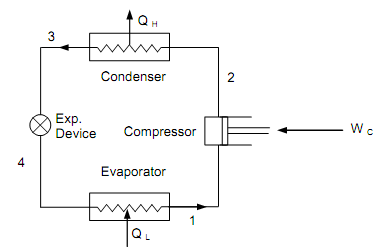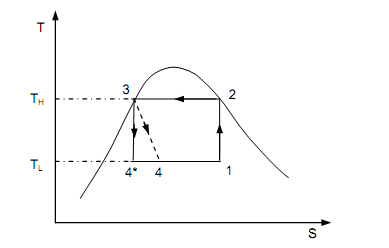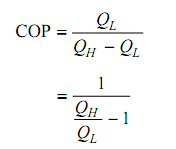Carnot Refrigeration Cycle
The simple VCRS is irreversible in nature mainly since of the throttling procedure 3-4. When this procedure could be substituted by a reversible expander and the work acquired by this could supplement the work needed by the compressor we get an overturned Carnot cycle operating among TH and TL. Under such conditions the COP of the refrigeration cycle shall be the utmost. Such an upturned Carnot cycle is shown in the T–s diagram of figure shown below. In this figure whereas
1-2-3-4*-1 is the Carnot cycle,
1-2-3-4-1 is the analogous simple VCRS, both operating among the similar temperature limits of TH and TL. The COP of Carnot cycle has to be more than that of the VCRS since of both raised refrigerating effect [from (h1 – h4) to (h1– h4*)] and reduced work input.

Figure: Schematic of a Simple VCRS

Figure: Carnot Refrigeration Cycle
from (h2 – h1) to [(h2 – h1) – (h3 – h4)].
The Carnot cycle is a reversible engine and therefore the ratio of heat transfers is equivalent to the ratio of the condensing & evaporating temperatures.
By its definition,

Substituting the ratio of heat transfer by the ratio of temperatures and on rearranging them,

No refrigeration cycle working among given TH and TL can be thought of as a model of perfect refrigeration cycle, it is impractical as the work acquired by expanding the high pressure liquid in the expander is too unimportant that it does not warrant the employ of the expander at an additional cost and added troubles of its operation and maintenance.
In real practice, while a short capillary tube can do the job of expansion in minute VCRS, a simple expansion valve does the same job in large VCRS. It is for this purpose that efforts are not made to substitute them by expanders.